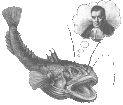UW Aquatic & Fishery Sciences Quantitative Seminar
Kiva Oken
University of Washington, Quantitative Ecology and Resource Management
A simulation-based approach towards testing detectability of the influence of predators on mid-trophic level fish
Abstract
Available tools to detect predation regulation in prey populations are limited. This is partly because available data often aggregate a population’s age structure into a single biomass or abundance metric, whereas many food webs are complex, with prey species subject to different assemblages of predators throughout their ontogeny. We evaluated the extent to which stage-structured predation could be reliably detected from time series of total biomass of predators and prey. We simulated age-structured populations of four life histories of mid-trophic level fish, exposed them to variable predation at different life stages, and fit production models to resulting population biomass to determine how reliably the effects of predators could be detected. We show that predation targeting sub-mature life stages generally led to larger fluctuations in annual production, and was therefore more detectable, but realistic levels of observation error and environmental stochasticity masked most predator signals. Including a second predator in the operating and statistical models sharply decreased the detectability of both predators, even when the signal was easily identified for a single predator. Therefore, an absence of detectable species interactions from biomass time series may be partly due to the interactive effects of environmental variability and complex food web linkages. We conclude with an attempt to investigate predation using aggregated biomass data from several North Atlantic ecosystems.

